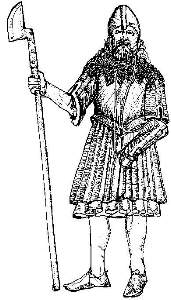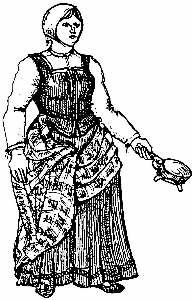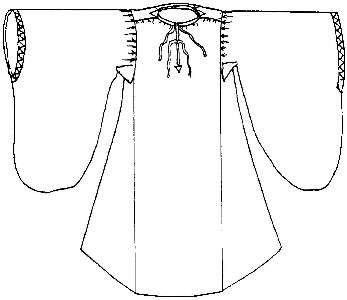Basic Guide
How We Do It...
One you know who and what we are, the question is HOW do we do it? In Grand
Style, of course! We learn what we can and teach all we can. We have a
great time doing it, too. We learn how to work together to create our presentation,
using the customs, traditions, and skills of the people we portray.
Our Highland Lifestyle
It is important to remember that most of our time in the 16th century was
spent getting a living from the land and water. Much of what we regard
as "crafts" now, were necessary survival skills then. EVERYONE caught,
gutted, salted, dried and cooked fish. EVERYONE helped clear, plow and
plant the fields. EVERYONE helped harvest the kail and the barley. EVERYONE
helped pluck and gather wool. EVERYONE pitched in to build or mend a house.
There was a great leveling influence in being a small group with a lot
to do.
But still, each person had a special knack for something, and folk would
go to whoever was best at something they needed done. Households, specializing
in one thing or another, attracted others who wished to learn. When the
need to do other things was not pressing, the smith was at his forge, the
weaver at his loom, the herbalist at her infusions, or the storyteller
teaching youngsters the old tales.
A 16th century Chief's household was the hub of much of Clan life. Clan
folk came and went with news, questions, gifts, messages, requests, and
complaints. A successful Chief's household was usually fairly large as
it had to include the people who carried on this business. "Large" in no
way ranks such a household with a manor full of liveried servants, however!
Members of the Chief's household might share the stone tower house and
dining hall with the Chief's family (and possibly the Chief's livestock),
or might live nearby in outbuildings or neighboring houses. There would
likely be a ghillie or two, the Chief's henchman or bodyguard, and a woman
or two to tend to the fire and the cooking and cleaning. The Chief's wife
would supervise the housekeeping and hold the keys to the "kists", or chests,
that held the family plates, spices and paraphernalia. There might also
be foster children, bastards, an unmarried son, brother or an elderly kinsman,
actually living in the Chief's house. Since even tower houses tended to
be small, there was a limit to the number of people who would regularly
bed down on the floor.
Our present Chief, Steven Gillan (Stiofan A Giollain Mac Colin), has
a household that includes himself and his wife Christal (Kristin- titled
"Baintighearna"). He also has a piper, a bannerman-ghillie, a housekeeper,
a seamstress, a tutor for the Tanist, and various others with specific
functions in the house. The Chief's wife is attended by a "suite" of women,
including widows of good families and wives of men with duties at the Chief's
holding. Among these folk are both Scots and Irish. Our Chief is well-read
and is a primary source of information for all our activities. His wife
and daughter are excellent dancers.
His daughter Jessica (Iasaca, the nominated heir, or "Tannist") has
been declared adult with her own establishment one Isla Ewe, with tenants
and retainers.
In Clan Mac Colin each primary household also has subhouseholds. In
the sixteenth century, as now, family and kinship had much to do with who
was in what household, but not exclusively so. Often there were several
factors, and the relationships of households were complex. For administrative
purposes the primary consideration was tenancy. Almost all of the land
was held in tenancy. The Captains (Tacksmen) held directly from the Chief,
and subhouseholds held from them. This might go to several levels.
Ceann Tighe Maccaolinn na Slaggen, Captain An Marshall Tieg, traditionally
in charge of the Chief's bodyguard and the watch on the Chief's home, trains
and drills the fighting men to the satisfaction of the Chief, orders the
march, and established table precedence. He is particularly good at instilling
a fighting spirit in the company. He is also responsible for conducting
court to resolve disputes not attended to by the Chief. He, Bill Voorhes
(Uilliam Mac Uilliam), is one of the Chief's Irish kinsmen.
Ceann Tighe Maccaolinn na 'An Doire, the Chief's Ghillie Cas Fliuch
(so called because it is his job to carry the Chief dry-shod over any stream
in the path) Paul Mohney (Sean-Pol), another Irishman and kinsman of the
Chief, is also a Captain in rank. He is our "Admiral," in charge of the
galleys in time of battle. Paul is also the Clan's bone and muscle realigner.
His household is one of the largest in Clan, and his kinship network is
extensive, both by blood and by marriage. It also serves as the entry household.
The Baintighe (Lady of the House) is Paul's wife Cecilia (Sile Dubh).
Ceann Tighe Maccaolinn na Tournaig, the Captain 'An Fear Sporran is
the Chief's treasurer and also serves as An Maor Bailie for Glenderry with
the civic responsibilities for the village, including administering the
rents. He, Norm Montgomery (Odo Montgomerie), a Scot, sits on the Baron
court. He is responsible for collecting any fines levied within the Clan,
and for knowing pretty much who has what. He has skills in leechcraft and
numbers, and is, in the 20th century, Keeper of the Database (send address
corrections to him!).
Bear in mind that the relationship of households, by tenancy, is not
the only chain. On the march, the Chieftain (A.K.A. Chief) orders the Marscall
Teig, who in turn orders the Sergeant Major, who orders the Squad Leaders
who pass orders to the pikemen, skirmishers and kerns.
The chain of command varies with the job to be done. While a Captain
may set the policy regarding a piece of construction, in helping with the
work, he will follow the lead of the Engineers. We show respect to our
"betters", and are a proud people, and would not fear looking the King
in the eye- God gave him his station and us our's!
Each of these households, and every tenant's household, represents a
microcosm of the activities at the Chief's household. There is always a
hearth to tend, food to be gathered, prepared and stored, animals to be
tended, clothes and tools to be made, etc. The magnitude of the tasks,
and the number of people doing them, are the only differences between the
greater and lesser households.
Which household are you in, and what functions do you have within it?
Also, who are your closest kin and how are they related through the households?
More on this in upcoming issues! For now, be sure you know your household,
and who heads it; know how to get in touch with him or her. If you're not
in a household yet, ask the Chief, an Officer, or an old-timer to suggest
one that fits your persona.
WHAT'S THIS "PERSONA" STUFF, ANYWAY?
By now everyone is at least briefly acquainted with the Clan requirement
that you have a 16th-century character or "persona" worked out. This has
been a part of Clan members' participation in Clan since its inception,
and over the years it has aided in the development of a real "family" sense
in the group.
First, you need a name, an age, a household, a family or connection
within that household, a marital status, and a set of activities. Some
of you have chosen to keep your own first names and, if they are Celtic,
or Biblical, or translatable into Scots or Irish, that's fine. Others have
discovered the list of Gaelic names in the Persona book, and have decided
to take a different name. I hope you all know that in our time surnames
were not used in the Highlands, or very much in Ireland. You would know
what
Clan you belong to, or what family in Ireland; but even transplanted Lowlanders
(who have surnames) would be known among the group by your first name,
a descriptive nickname, and/or your patronymic. Your patronymic is your
father's first name, preceded by "mac" ("son") if you're male, or "nic"
("daughter") if you're female. Women retain their own patronymic when married.
I've suggested that, if you're past adolescence, you take an age a little
younger than you are. People wore out faster then. If you're over fifteen,
you most likely are married, or handfasted, or widowed. You need to know
these things from a historical point of view - having lots of family connections
and children was your old-age insurance. Being a loner in the 16th century
is fine until you're forty-five, going blind from cataracts, and creaking
and croaking with assorted ailments. Then you're glad your grandchildren,
nieces and nephews are there to lead you out to the privy or fetch your
gruel, or even defend your house against a raid or overeager tax collectors.
If you aren't in a family yet, or if you don't remember your household,
do join one soon.
You'll have an easier time of it if you base you character on your 20th
century personality. Assess your characteristics and strengths and weakness,
and use them; you can try out new ideas with your character, but keep it
consistent with your abilities and preferences as they would be expressed
in the 16th century.
There are some questions that come up frequently, that needn't be asked
if you remember what the Clan's purpose is. We are an educational and theatrical
organization, researching and recreating the life of a Scottish-Irish extended
family of the mid sixteenth century. Our characters for the Clan are the
roles we play to achieve that purpose. Anything that doesn't enhance the
Clan's GROUP PERSONA takes energy away from our collective self,
and makes it harder to present a coherent theatrical experience. Aligning
your character with what we're trying to do makes it easier for everyone
to stay on track.
What you're doing when you create and use your Clan persona is, in effect,
helping to write a long running play. Imagine a television series. The
writers and directors stick very closely to the identity their audience
expects; they don't just drop unrelated characters or behaviors in and
out of the story.
It's important to remember that your Clan persona, like any other role
you frequently play (such as student, boss, driver, stamp collector) is
just that - a role. It's not a restriction on your real self. It can be
changed, altered, expanded, or dropped entirely without compromising your
personal essence. But it should always be appropriate to the situation,
just like a suit of clothes. When you choose to join the Clan situation,
you dress and act appropriately, or you find yourself excluded, just as
you would be in any other situation.
We are actors! We are acting the part of a bunch of 16th century pike-and-plough
tenders. Anything else is superfluous. There are other places (such as
the S.C.A.) where you can pursue other interests and develop other characters
you may fancy. Please do. But in our group, no, you can't play the half-Lithuanian
bodyguard of an Italian count. Be one of us. There's no reason to do otherwise.
Some people have asked if they can just use their own genealogy, and
Gaelicize the spellings of the names. To a point, yes. But your character
should be related to our other 16th century characters; we must have some
common ancestry in order to portray families. You can choose names for
certain relatives, but you'll have to share some lineage with others.
Frequently, newcomers want to play runaways from another Clan, orphans
found on the beach, or some other totally unrelated persona. This is natural;
you want to get to know people before making any commitments. The answer
to this is, again, we are ACTORS. When you try out for a play, the role
is already written. Here, your lines and actions are more flexible. You
start out with some kind of connection, learn what's expected there, then
look around to see what else is happening. You may find out you like your
first choice. Or you may decide to change. That's fine; we've all done
it. But meanwhile, you've had a base from which to work.
Occasionally someone asks to play an exotic character because he or
she is (in the 20th century!) Oriental, Black, Mexican, etc. Once again:
we are ACTORS. The color of your skin matters exactly as much as your hat
size. You are Celtic if you think Celtic. You get popped into a family
just like the rest of us. Cozy, isn't it?
We hope you have joined us because you are truly interested in learning
and portraying Scottish/Irish culture; and we want you to become part of
the genuine family of caring people that this group has become. One way
of doing this is through careful attention to your persona, both as a growing
personal story and as a basis for theatrical action. Households and families
should get together so each can learn the others' personas, and so everyone
can work out stage and street bits using the persona relationships. A tool
toward this end is the Persona Worksheet, which
will help guide the initial effort.
Clothing or "Costume "
Costuming is one of the most important considerations in Clan MacColin's
historical-theatrical existence.
Certainly, our other activities, such as research, crafts, marches,
and dancing must not be undervalued. But as the Bean Tigherna (the Chief's
wife) so correctly points out, it is usually our look that first draws
people's attention.
Our costuming serves several functions. It sets us apart from other
groups (e.g., the English and Italians at Faire, the modern and Victorian
Scots at Highland Games, etc.). It shows, as correctly as we know, the
type of clothing worn by Scots and Irish in the 1500's. It also gives us,
or should give us (!!) a look of belonging together. And finally, it allows
us to express our chosen personas (characters), and our relationships with
each other and the group. So, you can see that proper costuming is essential
in the Clan!
Each person working with Clan MacColin is expected to provide at least
one 16th-century Scottish or Irish outfit, appropriate to his or her character.
Costumes may be made, bought or borrowed, but they must be approved by
the Clan costuming authorities. This outline is only a sort of review of
the gear you will have to have for Clan events. The Clan MacColin Clothing
Guide is available for purchase.
Here is an outline of what the minimally dressed Clan member wears:
SCOTTISH MEN: Great-kilt and shirt, broad bonnet or tam, ionar (Irish
jacket) or cota, shoes and hose, belt, sporran, belt knife or dirk. Targe,
sword or axe or bow and arrows.
IRISH MEN: Leine, tam, ionar or cota and/or brat, shoes and hose, belt,
pouch, belt knife or dirk, Targe, sword or axe or darts.
SCOTTISH WOMEN: Shift, bodice, skirt, arisaide, kertch or biggins on
head, shoes and hose, belt. May have pouch, belt knife, apron.
IRISH WOMEN: Leine, Irish overdress or skirt and bodice, brat, biggins
or head wrap or "donut" coif, shoes and hose, belt. May have pouch, belt
knife, apron.
CHILDREN: As adults, but under age 10 may wear less of the overgear,
as comfort dictates. |
 |
 |
EVERYONE: Have available a cup, bowl, spoon and eating knife, and any
craft materials. Men may wear oak leaves as a bonnet badge. Women can carry
needlework, spinning, or other business - drop it in your basket, leine
sleeve or arisaide when not working at it. Very little jewelry is approved
- it's best to leave off everything but appropriate clasps (e.g., ring
pins). No feathers in hair or bonnet, unless you are a commissioned officer
or granted Gentle!
Follow Clan guidelines for making Clan costumes. The Clan MacColin Sumptuary
Laws must be observed. A great deal of research into available sources
has resulted in our present requirements. Clothing and fabrics must be
approved in advance.
The Costume Mistress (Regina Voorhes) reviews
and approves costumes. Captain An Marscall Teig reviews and approves weapons.
The Chief (Steven Gillan) is the final arbiter on any questions of dress. |
Choose natural looking colors and fabrics. Cotton, linen and wool look
better and are more comfortable than polyesters. Get a swatch of the material
and check with the Costume Mistress.
Our clothes are practical, so there is no fussiness and decorations.
Also, modern gear such as watches, glasses, most makeup, punk hair, etc.
are not appropriate for most of our appearances.
We do not use any plaid that is a registered Clan or Family tartan sett,
or that is well known (e.g., Dress Stewart, etc.). These designs came long
after the 16th century. Also, their casual use angers members of the Blood
Clans - and rightly so. |
 |
Head and foot coverings are required by many of the events we work
for insurance and health reasons. We require head coverings for sunstroke
protection.